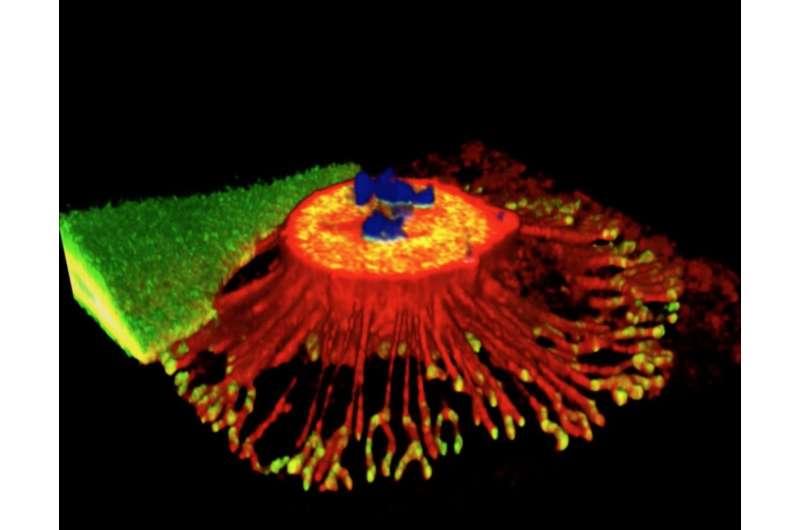Researchers have discovered a new cell structure

A new structure in human cells has been discovered by researchers at Karolinska Institutet in Sweden in collaboration with colleagues in the U.K. The structure is a new type of protein complex that the cell uses to attach to its surroundings and proves to play a key part in cell division. The study is published in the journal Nature Cell Biology.
The cells in a tissue are surrounded by a net-like structure called the extracellular matrix. To attach itself to the matrix, the cells have receptor molecules on their surfaces, which control the assembly of large protein complexes inside them. These so-called adhesion complexes connect the outside to the cell interior and also signal to the cell about its immediate environment, which affects its properties and behaviour.
Researchers at Karolinska Institutet have now discovered a new type of adhesion complex with a unique molecular composition that sets it apart from those already known. The discovery has been made in collaboration with researchers in the UK.
"It's incredibly surprising that there's a new cell structure left to discover in 2018," says principal investigator Staffan Strömblad, professor at the Department of Biosciences and Nutrition, Karolinska Institutet. "The existence of this type of adhesion complex has completely passed us by."
The newly discovered adhesion complex can provide answers to an as-yet unanswered question—how the cell can remain attached to the matrix during cell division. The previously known adhesion complexes dissolve during the process to allow the cell to divide. But not this new type.
"We've shown that this new adhesion complex remains and attaches the cell during cell division," says Professor Strömblad. The researchers also show that the newly discovered structures control the ability of daughter cells to occupy the right place after cell division. This memory function was interrupted when the researchers blocked the adhesion complex.
The study was done on human cell lines mainly using confocal microscopy and mass spectrometry. Further research is now needed to examine the new adhesion complex in living organisms. "Our findings raise many new and important questions about the presence and function of these structures," says Professor Strömblad. "We believe that they're also involved in other processes than cell division, but this remains to be discovered."
The researchers call the newly discovered cell structure 'reticular adhesions' to reflect their net-like form.
More information: John G. Lock et al, Reticular adhesions are a distinct class of cell-matrix adhesions that mediate attachment during mitosis, Nature Cell Biology (2018). DOI: 10.1038/s41556-018-0220-2
Journal information: Nature Cell Biology
Provided by Karolinska Institutet
















